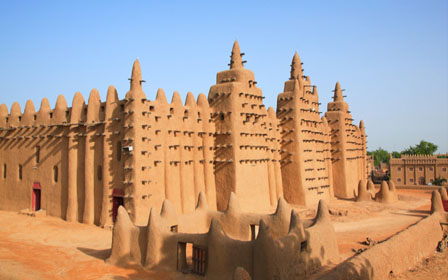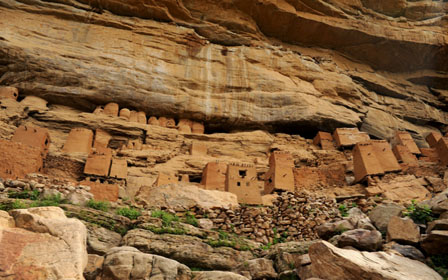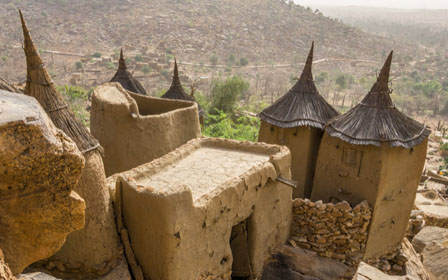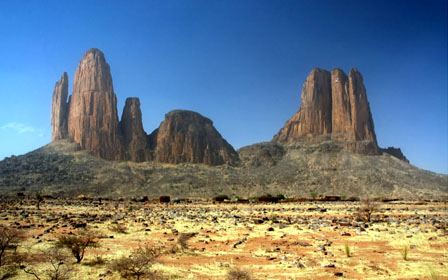Tales from the Griots - The Mali Empire
Introduction | Background Knowledge | Activities | Extensions | Standards

Introduction
The structure of modern society was built from the successes and struggles of the civilizations that came before them. Some of these civilizations existed over 5000 years ago. Some thrived for millennia. Others were shorter-lived. The Mali Empire existed in Africa for just over 400 years. During that time, the Empire spread its culture, language, laws, and customs across Western Africa while recording its history through the storytelling of the griots.

Background Knowledge
Sometime during the 11th and 12th centuries, the powerful Ghana Empire in western Africa began to decline. Many states along the Niger River vied to control the trade of salt and gold in the region. In 1235, Sundiata Keita, leader of Kangaba, one of these states, defeated a powerful rival, freeing the people from the rule of the Sosso Empire, and began to consolidate power. This victory is considered the founding of the Mali Empire.
As the Empire grew, its territory grew as well. The victory over the Sosso Empire opened trans-Saharan trade routes. The Empire grew west to the Atlantic Ocean and east past the large northern bend of the Niger River. It also grew south into the rainforest and extended to the coveted goldfields as well as the salt mines. Timbuktu became a leading trade center for the Empire. The Empire built wealth through taxes on trade.
Sundiata died around 1255. After that time, the kings of Mali were known as mansas. Mansa Musa came into power in 1312 and was the most influential leader of Mali. During his 25 year reign, he made a pilgrimage to Mecca, a 4000-mile journey. He made many charitable donations as his entourage crossed Africa. Upon his return, he brought scholars, government officials, and architects to Mali. He added mosques and libraries in Timbuktu to help increase Islamic education. His pilgrimage also brought attention to Mali in Europe. European cartographers included Mali on their maps of the world and included references to Mansa Musa.
In 1350, the Mali Empire began its decline. The line of succession became unclear and smaller states began to try and leave the Empire to keep trade profits to themselves. The Wolof were the first people to leave the Mali Empire. Around 1430, a small nomadic tribe took possession of Timbuktu. Smaller states in the region began to assert their own power against the Mali Empire, and the decline accelerated. The Mali Empire existed until 1670 when the Bamana attacked and burned the city of Niani. After that, the Empire ceased to exist and reverted to individual chiefdoms.
While its existence was short, the Mali Empire left a strong legacy. Much of what is known about Mali came from oral storytellers called griots. They kept the history of the Empire alive for centuries. Several historians also preserved the past. The Mali Empire left a system of checks and balances of power instead of the Mansas ruling with absolute power. Timbuktu was a trade center and a center of education for the Muslim world. The Empire had a vibrant economy as well. The Mali Empire proved that Africa was not lagging behind Europe in organization and progress.

ACTIVITIES
Selective List of Books
-
Sundiata: Lion King of Mali by David Wisniewski (ISBN 9780395764817)
- This is the story of Sundiata, who overcame many hardships before becoming the ruler of Mali.
- Learn more about Sundiata from Mr. Donn or Ducksters.
- Extend the study of Sundiata using this lesson plan from the Virginia Department of Education. Lesson 1, Activity 4: King for a Day, Lesson 2: Lion King of Mali Character Study, and Story Scenes from Sundiata are the lessons that directly relate to Sundiata.
- For older students (late elementary and older), prepare this reader's theater.
- This unit plan from the Kennedy Center is geared for middle schoolers and encourages students to create a Sundiata Festival after learning about Sundiata and the cultural aspects of Mali.
-
The Lion King of Mali is often compared to Disney's Lion King. If students are familiar with Disney's Lion King, Engaging History has an amazing lesson that has students create a comic strip.
- Non-Technology Approach - Use paper, pencil, and art supplies to create a comic strip.
- Technology Approach - Create a comic strip using Comic Creator (TeachersFirst review)
-
If You Were Me and Lived In…the Ancient Mali Empire by Carole P. Roman (ISBN 9781540337276)
- Go back to the 1300s and learn about Mali during the height of the Empire.
- PBS has a video about Timbuktu during the height of the Mali Empire. There is a background essay and discussion questions to deepen the learning.
- Explore the Gold Road Interactive Map. View the trade routes across varied landscapes and cities. Virtually visit cities with images.
- Compare and contrast the European trade routes with the trade routes of Ancient Mali.
- Extend the study of Mali using this lesson plan from the Virginia Department of Education. Lesson 1, Activities 1-3 and 5-6, Lesson 3, Lesson 4, and Map of Mali are good non-technology or low technology approaches to help students understand the culture and daily life of the Mali Empire.
-
The Hatseller and the Monkeys by Baba Wague Diakite (ISBN 9780590960694)
- A hat seller runs into trouble when a monkey steals his merchandise.
- Extend the lesson with a reader's theater script.
- Easy Literacy has a teacher's guide to support the story.
Videos
- Loren Klein - Mali Empire - This video is created for middle school-aged students. The lesson is designed for a flipped classroom, but the information is good for intermediate grades and up.
- Rise and Fall of the Mali Empire - This is a graphic-focused overview of the Mali Empire. This video is geared for intermediate grades and up.
- Extra Credits has animated videos about the Mali Empire. They are numbered for easy viewing.
- African Odyssey: A Sogolon Puppet Theater - This performance out of the Kennedy Center brings the puppet tradition of Mali to life. Extend this lesson and have students create their own puppets and use them to tell the story of the Mali Empire.
- Griot Traditions - Students can hear storytelling in the Griot style.

EXTENSION
Compare and Contrast
- While much is unknown about the Mali Empire, there is enough information to compare it with the civilizations in Europe and Asia. Students can create a comparison chart or Venn diagram on Canva (TeachersFirst review) to compare and contrast influential civilizations.

CORRELATION TO STANDARDS
-
AASL National School Library Standards
- Inquire Shared Foundation, Think Domain - Learners display curiosity and initiative by: 1. Formulating questions about a personal interest or a curricular topic. 2. Recalling prior and background knowledge as context for new meaning
- Inquire Shared Foundation, Grow Domain - Learners participate in an ongoing inquiry-based process by: 1. Continually seeking knowledge
- Include Shared Foundation, Create Domain - Learners adjust their awareness of the global learning community by: 2. Evaluating a variety of perspectives during learning activities
- Include Shared Foundation, Grow Domain - Learners demonstrate empathy and equity in knowledge building within the global learning community by: 2. Demonstrating interest in other perspectives during learning activities
- Curate Shared Foundation, Create Domain - Learners gather information appropriate to the task by: 2. Collecting information representing diverse perspectives
- Explore Shared Foundation, Think Domain - Learners develop and satisfy personal curiosity by: 1. Reading widely and deeply in multiple formats and write and create for a variety of purposes. 2. Reflecting and questioning assumptions and possible misconceptions.
- Explore Shared Foundation, Share Domain - Learners engage with the learning community by: 1. Expressing curiosity about a topic of personal interest or curricular relevance
- ISTE Standards for Students
- Knowledge Constructor - 3d. Students build knowledge by actively exploring real-world issues and problems, developing ideas and theories and pursuing answers and solutions.
